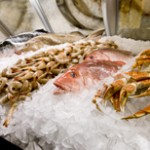This may sound like a fish story, but it’s true! People are eating more fish and shellfish than ever before! While seafood has always been popular in the South as a whole, no area is more graciously endowed with an abundance of fresh seafood products than the northern Gulf Coast. The warm waters of the Gulf of Mexico abound with many delicious saltwater fish, as well as a plentiful supply of shrimp, crabs, scallops, and oysters.
of shrimp, crabs, scallops, and oysters.
Fish and shellfish have become an even more important part of the diet as people turn to more healthful eating. People are choosing fish and shellfish more for several other reasons as well—it is economical, high in nutritive value, quick and easy to prepare, versatile, and, best of all, seafood is great-tasting.
Buying seafood can be a daunting process because of the huge variety of market forms available, yet with general guidelines you can easily learn to recognize quality and freshness.
Always purchase your fish and shellfish from a reliable dealer who will stake his reputation on the quality and freshness of his merchandise. Seafood is a highly perishable commodity, and therefore should be purchased as near to the time of preparation as possible, and as close to the time the catch was made, if that information is available.
When buying fish, look for bright, clear, bulging eyes; reddish or pink gills; tight, shiny scales; firm, elastic flesh that springs back when pressed; and a pleasant salt-water-like odor. Fresh shrimp should be slightly green in color and firm to the touch. Shucked oysters should be plump with no evidence of shrinkage. The liquid in which oysters are packed should be clean, fresh, and sweet-smelling. Scallops are usually sold shucked. Select scallops that are cream-colored rather than white.
Fish and shellfish are best if cooked the day of purchase, but can be stored no more than two days in the coldest part of the refrigerator, preferably on ice. Frozen fish and shellfish should be kept solidly frozen until ready to thaw. Frozen seafood will remain fresh for four to six months. Cook seafood immediately upon thawing. Never refreeze seafood.
Most fish and shellfish can be cooked using a variety of methods. Seafood can be broiled, grilled, deep-fried, poached, steamed, baked, panfried, and sautéed. Particular care must be taken not to overcook seafood.
Many seafood aficionados/enthusiasts prefer flavoring their dishes with only small amounts of salt, pepper, and occasionally lemon, yet the delicate taste of seafood blends exceptionally well with a variety of herbs, spices and seeds, as long as those seasonings are used sparingly so as not to overwhelm the flavor of the seafood.
So the next time you are in the neighborhood of your favorite seafood market, stop in. Remember that fish and shellfish from the Gulf are nutritious, economical, quick and easy to prepare, and taste great. And that’s no fish story!
SWEET-AND-SOUR SHRIMP
1 pound shrimp, cooked, peeled, and deveined
¼ cup margarine
1 onion, thinly sliced
1 bell pepper, diced
1 (8¼-ounce) can pineapple chunks
½ cup white vinegar
¼ cup white sugar
2 tablespoons cornstarch
1 tablespoon soy sauce
½ teaspoon dry mustard
1 teaspoon pepper
¼ teaspoon salt
Cut shrimp into bite-sized pieces. Heat electric wok to 350°F and melt margarine; cook onions and bell peppers until they are crisp-tender.
Drain pineapple, reserving syrup for sauce. In a large bowl blend together pineapple syrup, vinegar, sugar, cornstarch, soy sauce, dry mustard, pepper, and salt. Mix well. (Note: a whisk will aid in thoroughly blending ingredients.)
Stir sauce into sautéing onion and bell pepper; cook until sauce thickens. Gently stir in pineapple chunks and shrimp. Heat until pineapple and shrimp are hot. Serve over hot rice.
Author: Dorothy C. Lee, Family and Consumer Sciences Agent, UF/IFAS Escambia County Extension
- What’s Brewing – Tea – National Tea Day - April 19, 2024
- Stress Around the Clock - March 22, 2024
- WOW! Your Guests with Holiday Baking - December 15, 2022
